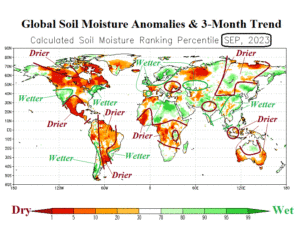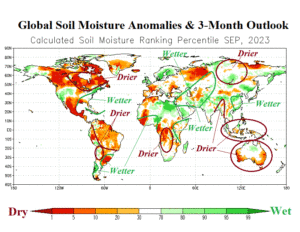Tropics Present High Impact Weather This Weekend and Next Week
10/05/2023, 8:08 am EDTNorth Atlantic Upper Shear Increasing Rapidly as TC Season Begins to Fade
10/12/2023, 10:20 am EDT
Fig. 1: Global soil moisture anomalies and 3-month trend.
Observation discussion: Global soil moisture trend during Q3/2023 featured MUCH DRIER changes across already drought-stricken Mexico and into Texas plus North/Central Brazil to Argentina all related to the El Nino warm oceans of the far eastern tropical Pacific (Fig. 1). Wetter soils were observed across the Northeast U.S. where record rainfall occurred and the Southwest U.S. In South America, El Nino-like conditions affected Southeast Brazil and Chile. Drought emerged in Ukraine while the Baltic Nations observed a drought fade. The Northwest Africa/Southwest Europe drought eased back slightly. The southern tropics of Africa observed a drier trend. The Russia spring wheat growing areas were wetter during the late warm season while Central India was drier. Northeast Asia was drier while Southeast Asia was wetter during Q3/2023. Parts of Western Indonesia and much of Australia trend drier entering Q4/2023.
Forecast discussion: During Q4/2023 expect a wetter shift across the Southeast U.S. including the Caribbean Islands (Fig. 2). The wetter El Nino-driven change is not likely to extend to the Central U.S. drought zone away from the Gulf Coast. North of the large wet zone, the eastern half of Canada is dry. In South America, much of Brazil is drier and drought develops in Central Brazil. Southeast Brazil is wet, and the Argentina drought should begin to ease. A large wet zone is projected across the Middle East and Northeast Africa related to the positive Indian Ocean dipole (+IOD). El Nino-inspired dry climate is likely across Central Africa, Indonesia, and Australia while East China is wet.

Fig. 2: Global soil moisture anomalies and 3-month forecast.
